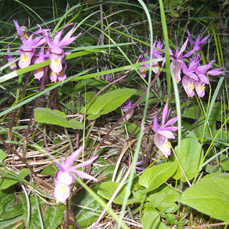 The outskirts of Cranbrook provide many opportunities for a quick evening walk on an early June evening. Marianne and Daryl led naturalists on a mini adventure, a short distance from the north end of Wilks Road. The first goal was an unusually dense patch of Calypso Bulbosa, (Fairyslipper, Venus-slipper or Calypso). Although one of our smallest orchids, this is the most exquisite as well as the most elusive. It’s favourite habitat is in Pine woods where it grows in the damp litter of the forest floor. This true member of the orchid family, grows from a corm, or tuberous rootstock, which is all that remains after the plant flowers and seeds in early summer. As with all orchids, this flower grows only in association with a certain type of fungus. As a result, it is virtually impossible to transplant. This plant suffers from over-picking by collectors. Picking of this flower will kill the plant, so it is best to remember to leave this, as well as all flowers, to mature unimpaired. Earlier, we counted over 100 orchids in an area of about 1 square meter. This patch may be successful because of continuous shade, abundant rotting material and it’s secluded location. Leaving the dense, north facing forest, we walked up a south aspect, grassy slope. The yellow arnica and balsam root were amazing, interspersed with numerous, fragrant, light yellow bitterbrush flowers. These small, rose-like flowers attract night flying moths which provide an important food supply for the Common Poorwill. A small nightjar of the arid West, this Poorwill is the smallest member of it’s family in North America. It is one of the few birds known to hibernate in the winter. It is very well camouflaged, colored in browns, black and grey. This medium-sized bird is large headed with a tiny bill and very tiny feet. This bird can slow it’s metabolic rate and drop it’s temperature, going into a hibernation-like state known as torpor. In periods of cold weather, when insects are inactive, a poorwill may stay in torpor for several weeks. These birds hide during the day, emerging at dark to feed. They are very difficult to see, but several were heard during the week of the outing, flying past our house on Wilks Road near midnight. Submitted by Daryl Calder  At the Effluent Irrigation ponds. At the Effluent Irrigation ponds. Another 'Little Big Day' has come and gone. boohoo. Twelve hours of 'speed birding' to see which team can get the most species is so very much fun! About the Date This year was a little different because we held the day two weeks later than usual. In the past, it was always held on the second weekend of May, around Mother's Day. "Would not we get more songbird species if Little Big Day was a little later in the month?" some wondered. "Yes", we thought, but then we might miss late wintering species such as Rough-legged Hawk. And also, if we changed the weekend then we wouldn't be able to compare the species list from year to year. Well, this year, since some of the team leaders were not available on the usual weekend, we DID change the date; Little Big Day 2014 was held 24 May 2014 and, indeed, in those extra two weeks of spring, several migrant species were recorded which were rare on previous Days. Just off the top of my head, these include Lazuli Bunting, Gray Catbird, Lewis' Woodpecker, Least Flycatcher, American Redstart, Northern Waterthrush, and Bobolink, to name a few. Yet we also got Rough-legged Hawk! So, go figure. About the Participants But it is not all about the birds, nor the competition between the teams. It is about sharing this experience and having fun. This year we welcomed our first ever team from up the Valley! The Columbia Lakers, consisted of Elaine, Sandi, Peter, and Randy all from Fairmont. Yay! And we had some first-time LBD'ers too! They were George, Audrey, Candace, and Helga. I hope we didn't blow them away with our awesome 'ear-birding' skills and I hope they had a really good time. (PS - a really good app I highly recommend for learning bird songs is Larkwire) We missed terribly Lois, Art, and Dean - long-time LBD'ers who could not take part this year, and Tony, of course. This year, we also didn't have a 'biking' team, who have taken part in about the last three Little Big Days and had done very well for themselves. Some of them joined / returned to the gasoline-powered teams, and that is just fine! And we were happy to welcome back many of the regulars. Way to go, teams!  at Reade Lake, Wycliffe, BC at Reade Lake, Wycliffe, BC My Team and Our Day We had a GREAT day! Not too hot, not too cold, no dead car batteries, no getting stuck in the mud or dust, no really short tempers, nor distracting injured Burrowing Owls needing rescue, yet lots of good species and really good company. Ruth set out a really good plan, having scouted out some warblers earlier in the week up at the Nordic Trails at the Kimberley Ski Hill, so we went to get them first - and we got them all! PLUS we got what I consider my bird of the day - Hermit Thrush, and indeed, no other team got it. We just heard it, didn't see it, but such a beautiful bird and song. A couple of species we dipped on were Long-billed Curlew and Calliope Hummingbird, if you can believe that. (shakes her head). The Sage Thrasher spotted earlier in the month has not been seen since.  Almost all the LBD participants & guests. Missing Kathy, Al, & Candace. Almost all the LBD participants & guests. Missing Kathy, Al, & Candace. Count-up Dinner The count-up dinner this year was held at The Heritage Inn, Cranbrook, BC. The dining room was comfortable, pre-ordered menu items meant our dinners were prompt in arriving - something well appreciated after a long day, and the food and service were great! Results: Here, I COULD put a list of all of the amazing, whopping, outrageously fantastic 139 species all the teams saw; or I could just give you the link to the document online. Yes, you read that right - one-hundred and thirty-nine (man we're good). 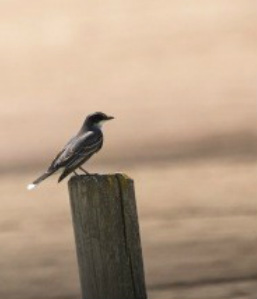 Team Results: Friends of a Feather - 112 sp Dianne, Ruth, Lyle, George Deaf & Dumb - 107 sp Peter, Audrey, John Birding Trio - 103 sp Alan, Kathy, and Candace Columbia Lakers - 95 sp Elaine, Sandi, Peter, Randy Merlin Wantab's - 95 sp Greg, Sue, Glenda, Helga _ This year's trophy goes to Extra photos It can be lonely out there in the dry fields, but the pickin's are good. I wasn't too attentive at the count-up dinner after 13 hours of driving or birding and missed writing down everyone's following:
How was your Day? What was your Best Bird? Biggest 'dip'? Leave a comment! Photo credits: Lyle Grisedale and Greg Ross Blog post by Dianne C. Apr. 27, 2014 - Dutch Creek Hoodoos/Headwaters of the Columbia River Hike
Thirteen eager RM Nats braved a variety of weather elements on their journey up to the top of the Dutch Creek Hoodoos. A bounty of spring crocuses along with a multitude of other plants including pussy toes, balsam root, prairie sage, pasture sage, wild onion and buffaloberry (Soopolallie) lined our gradual upward journey. Once at the top of the saw-toothed ridges of the hoodoos breathtaking views, even with the billowing clouds, could be seen in every direction. Our very knowledgeable leader Daryl explained how the hoodoos were formed thousands of years ago and the composition of them. A narrow, sandy path wound its way along the rim of the hoodoos providing spectacular views down the sheer ravines to Dutch Creek far below while in the distance Columbia Lake glistened in the occasional sunburst. We were delighted to spot Canada Geese, Turkey Vultures, Osprey, Cooper’s Hawk, Red-Tailed Hawk, Northern Flicker, Clark’s Nutcracker, Common Raven, Black-Capped Chickadees, Red-breasted Nuthatches, Ruby-Crowned Kinglets, Townsend’s Solitaire, Common Loon, Bald Eagle, Tree Swallows, Brewer’s Blackbirds, various waterfowl as well as an abundance of Kestrels and Western Meadowlarks. From the Dutch Creek Hoodoos we proceeded to the source of the mighty Columbia River at Canal Flats. An easy stroll along a path lined with poplars, spruce and willows afforded views of huge boggy areas covered in grassy hummocks and undergrowth including budding birches and red-osier dogwood stems. We contemplated the difficulties which David Thompson must have encountered as his party portaged south to the Kootenay River 200 years earlier. At the edge of the woods, a series of springs formed little channels which converged and flowed to the North. Large patches of cattails, water grasses and roses grew in profusion throughout this area. The streams flowing out to the lake were crystal clear and by the abundance of tracks along their edges, provide drinking water for the many animals that frequent this area. At this area we added Ruffed Grouse, Dark-Eyed Junco, Killdeer, American Robin and Red-Winged Blackbird to our list of birds. The perfect ending for our day was spotting an osprey with a fish held in its talons looking for a place to have its lunch as well as field after field of shooting stars in full bloom creating a magenta carpet along the roadside at Skookumchuck Prairie. Submitted by Paula Rogers |
where we talk about
|
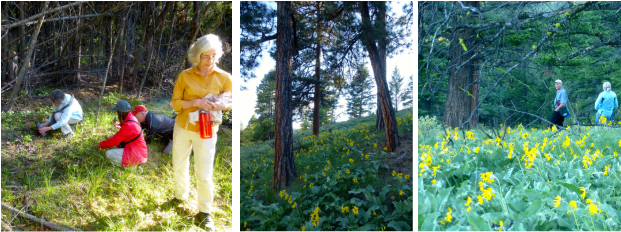
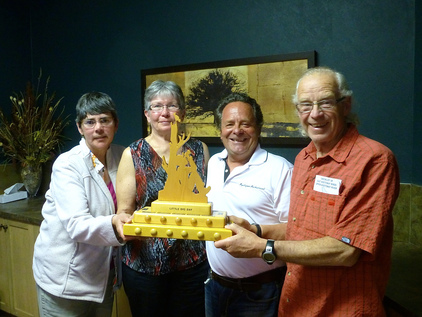

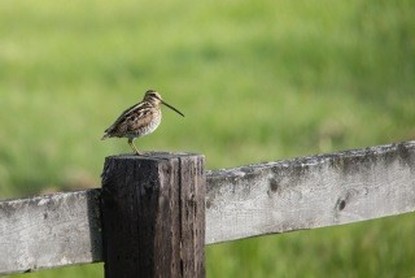

 RSS Feed
RSS Feed
